Carita’s Maison de Beauté Set to Reopen

PARIS — Carita is upping its game.
“We really want Carita to be the jewel in [L’Oréal’s] luxury division in skin care,” explained Charles Finaz de Villaine, Carita international brand director.
More from WWD
A key element of that strategy is Carita’s renovated 19,375-square-foot Maison de Beauté on Paris’ Faubourg Saint-Honoré. The flagship is due to open Oct. 3.
Carita was inaugurated there by sisters Maria and Rosy Carita on Dec. 15, 1952, in the presence of the Duchess of Windsor and 3,000 high society folk.
The duo set shop up on the ground floor, and ultimately coiffed the well-heeled, had their own product lines, and ignited the trend for wigs and hairpieces.
With the institute’s renovation, beginning two years ago, the objective was to create the most desirable beauty address in the world, according to Finaz de Villaine. The Carita team looked to what the Carita sisters developed.
“When they created this house, they called this ‘the hive,’” he said. It buzzed with 200 clients daily.
“It was a place where everyone wanted to be seen,” continued Finaz de Villaine. “You could have your hair done next to Catherine Deneuve and Brigitte Bardot.”
Carita’s institute boasted 100 employees, had 45 telephone lines and sold shoes, hats and scarves.
Rev Studio founders, architects Christiano Benzoni and Sophie Thuillier were briefed about Carita’s golden age, in the ’50s through the ’70s.
“They came up with this concept of creating a modern, contemporary hive,” said Finaz de Villaine. “What they really wanted to do was create a place where light is at the heart of the architecture.”

People enter the institute through Carita’s signature portico, then pass under a series of arches to reach a concept store. On this level, skin diagnostics are made in one of three alcoves, and there’s a checkout area.
Benzoni and Thuillier conjured up a glass-topped central atrium soaring 66 feet high that lights stairways and walkways.
As part of the sustainability drive, materials such as white and black marbles, pink onyx and chromed metal are used. Furniture includes Pumpkin sofas and Tulip armchairs by Pierre Paulin.
On the first floor up there are 11 black-and-white treatment rooms, including one double, measuring 108 square feet to 183 square feet. Five are reserved for face care, four for body care and one for eye enhancement.
Carita’s treatments use choreographed gestures, including almost 60 hand movements, and beauty tech.
A level above is the 915-square-foot hair salon with arched mirrors, nine stations and a 302-square-foot private salon, linked by a walkway.

Also on this floor is Rosy, the 1,345-square-foot restaurant seating 35, where healthy dishes are dreamed up by chef Amandine Chaignot.
“Within the Carita brand there is this sense of joy. The Carita sisters used to open Champagne at 6 o’clock every day,” said Finaz de Villaine. “So we needed a bar, a place where all this joy and conviviality can happen.”
Chaignot was chosen to channel this spirit.
On the third floor up nestle more treatment rooms, plus The Look Studio, centered on eyelashes and semi-permanent makeup. Here, as well, is a private apartment with a living room, dining room, hairdressing suite and double treatment suite.
The Carita Maison de Beauté can be a full-day destination.
“We really want this address to become the worldwide landmark for beauty, to develop the Carita experience as far as we can and to push the boundaries of luxury in everything we do,” said Finaz de Villaine, who cited the Carita sisters’ saying: “At Carita, we take care of your dreams.”
Services — including skin care, makeup and hairdressing — were inherent to this.
“We asked ourselves: ‘If the Carita sisters were alive, what would they have done in this concept of global beauty, where they were pioneers,” he said.
Cutting-edge beauty diagnostics, called “augmented consultation,” includes technology to measure “skin aura” — in line with the Carita sisters’ obsession with illuminating skin and hair.
To orchestrate the Maison de Beauté, Carita signed on celebrity hairstylist John Nollet as artistic director.
“We needed to have someone who really knows what the elite are looking for, how to talk to the most demanding clients,” said Finaz de Villaine. “Very quickly, when we tried to find the equivalent of the Carita sisters in today’s world, it was so obvious that John has it all.
“He has accumulated an experience in beauty, in client knowledge, that makes him the best partner to take care of all the details,” the executive continued.
Another of the sisters’ axioms was: “At the Maison de Beauté, everyone should be welcomed and treated like a queen.”
“We gave this sentence to John, and he really made it a reality,” said Finaz de Villaine.
Nollet helped choose the staff. Katia Dufon-Schaffhauser was named director of the Maison de Beauté Carita, for instance.
Nollet designed uniforms and proposed the music playlists.
“He brought his vision on hair care,” said Finaz de Villaine. Nollet reviewed Carita’s archives, including thousands of drawings by the sisters’ nephew, Christophe Carita.
The Maison de Beauté has been conceived as a prototype, therefore portions of it can be replicated on a smaller scale elsewhere.
The institute will be officially inaugurated during Paris Fashion Week, on Sept. 30.
“The Carita sisters were the first founders to really connect beauty with fashion and cinema,” said Finaz de Villaine. So things have come full circle.
Carita became part of the L’Oréal brand portfolio when it was sold by Shiseido alongside Decléor for a total of 227.5 million euros in 2014. At that time, L’Oréal said the two French brands together generated sales of about 100 million euros, which ranked the pair combined as number two in the global professional skin care market across beauty institutes, spas and salons.
Carita and Decléor were moved into L’Oréal’s Professional Product Division, but then quickly the market evolved, causing professional hair care businesses to have to reinvent themselves — particularly when it came to digital transformation. And the division focused on its core activity.
“When I deep dived into the archive, the brand story, I felt that Carita had really strong fundamentals,” said Finaz de Villaine, who signed on to the brand in 2018. “It had [everything] to succeed, but not in the professional division — more on the superpremium market.”
Carita in the early 2000s had lost some footing in the luxury industry, the executive explained. So key was to strengthen the brand fundamentals and sharpen its platform.
A new Carita, with a much more luxurious positioning, was proposed to top L’Oréal brass. Then the proposition was tested in China and France.
“It worked tremendously well,” said Finaz de Villaine. That resulted in Carita being moved to the L’Oréal Luxe division at the end of 2018.
Carita’s relaunch started in early January of this year, with the reworking and premiumization of its 20-stockkeeping unit product offer centered around face care, with new formulations, packaging, protocols and tech. The three main lines are centered around skin repair, remodeling and rejuvenation, as well as some signature products, such as Le Fluide 14.
Within the L’Oréal Luxe Division, Lancôme has face care priced at upward 200 euros and Helena Rubinstein above 400 euros. Carita’s price points, meanwhile, can surpass 500 euros.
“The bestselling range is the most premium right now,” said Finaz de Villaine.
The brand’s distribution remains tight, including high-end beauty institutes and hotels. Carita recently inaugurated its first boutique in China.
Its body care line is due out in 2023. “We are considering the launch of other categories in the future,” said Finaz de Villaine. Hair care might be among them.

